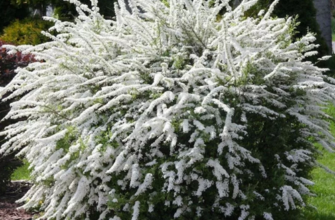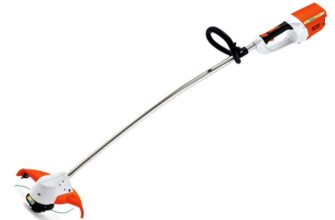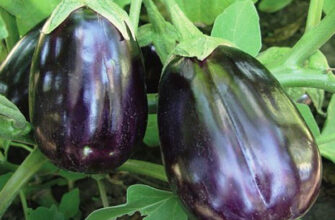Review of the best according to the editorial board. On the selection criteria. This material is subjective and does not constitute advertising and does not serve as a purchase guide. Before buying, you need to consult with a specialist.
Thuja is an evergreen, frost-resistant plant. It can be a small ornamental shrub or tree, reaching an average height of 3.5 m. Thuja is quite unpretentious and does not require special care. The color of her needles is most often green, but there are varieties with golden, blue or yellow.
Branches and needles resemble cobwebs. The needles have a vertical arrangement. The needles are in most cases scaly, but in some species they are needle-shaped. When planting thuja, take into account that this plant is afraid of strong winds. In the first years after planting, it is recommended to cover it for the winter. Different varieties differ in their strength of growth, level of resistance to drought or cold temperatures, and the ability to survive under adverse conditions.
When choosing varieties of thuja, first of all, attention is paid to its decorative effect. When composing the compositions, the size of an adult plant and the shape of the crown are taken into account. Tuyu is actively used not only in external landscape design, but also for the decoration of indoor spaces. In this review, we'll look at the best pyramidal and globular thuja varieties.
- Rating of the best varieties of thuja
- The best varieties of thuja pyramidal
- Brabant
- Advantages
- disadvantages
- Sunkist
- Advantages
- disadvantages
- Golden Smaragd
- Advantages
- disadvantages
- Thuja Columna
- Advantages
- disadvantages
- Thuja Fastigiata
- Advantages
- disadvantages
- Holmstrup
- Advantages
- disadvantages
- Thuja Wagneri
- Advantages
- disadvantages
- The best varieties of thuja spherical
- Thuja Reingold
- Advantages
- disadvantages
- Tuya Hozeri
- Advantages
- disadvantages
- Tuya Mister Bowling Ball
- Advantages
- disadvantages
- Teeny Tim
- Advantages
- disadvantages
- Tuya Little Jam
- Advantages
- disadvantages
- Woodwardy
- Advantages
- disadvantages
- Thuya Miriam
- Advantages
- disadvantages
- Tuya Danica
- Advantages
- disadvantages
Rating of the best varieties of thuja
| Nomination | a place | Variety | rating |
| The best varieties of thuja pyramidal | 1 | Brabant | 5.0 |
| 2 | Sunkist | 4.9 | |
| 3 | Golden Smaragd | 4.8 | |
| 4 | Columna | 4.7 | |
| 5 | Fastigiata | 4.6 | |
| 6 | Holmstrup | 4.5 | |
| 7 | Wagneri | 4.4 | |
| The best varieties of thuja spherical | 1 | Reingold | 5.0 |
| 2 | Hoseri | 4.9 | |
| 3 | Mr bowling ball | 4.8 | |
| 4 | Teeny Tim | 4.7 | |
| 5 | Little Jam | 4.6 | |
| 6 | Woodwardy | 4.5 | |
| 7 | Miriam | 4.4 | |
| 8 | Danica | 4.3 |
The best varieties of thuja pyramidal
The pyramidal thuja belongs to the western variety of this evergreen tree. Under favorable growth conditions, they can live up to 100 years.
Brabant
Rating: 5.0
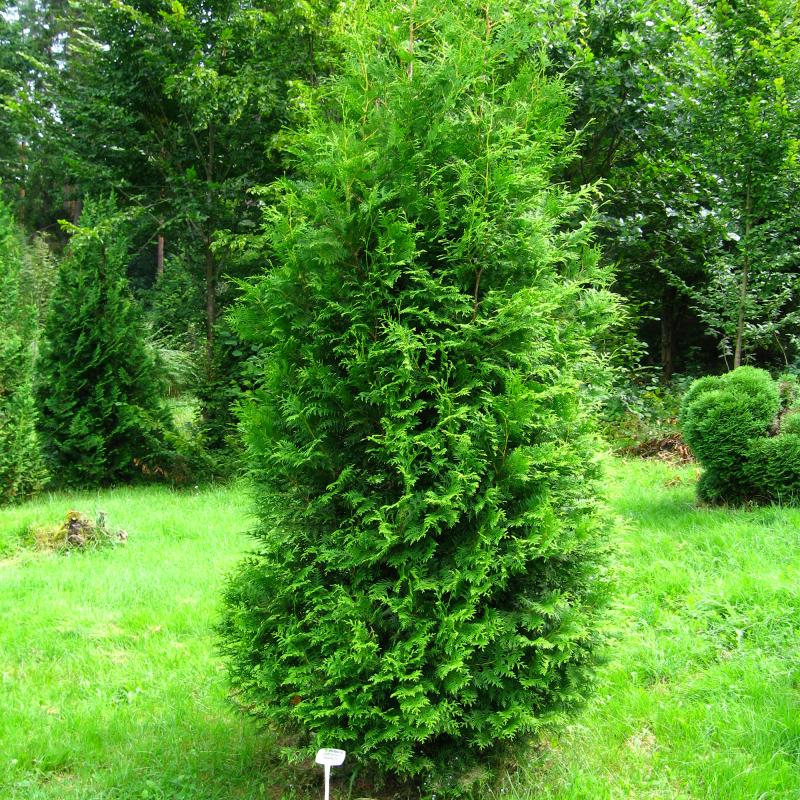
The pyramidal variety of thuja Brabant is capable of growing up to 3.5-5 meters in height. The diameter of the branched wide part of the tree is 1.5 m. In newly planted thujas, the crown is quite dense, but over time it becomes loose. Each year it grows 30 cm high and 10 cm wide. Such a tree feels quite well in urban conditions, where it often makes up hedges.
Thuja Brabant needles are scaly with a green color that lasts all winter. This variety is characterized by flowering in spring, at the end of which small (0.8-1.2 cm in length), oblong, brown cones are formed. At a young age, it is recommended to shelter the thuja Brabant for the winter, since its needles are still especially sensitive to low temperatures and the spring sun.
According to reviews, the Thuja Brabant variety grows well both in sufficient lighting and in light shade. But the more sun it receives, the more decorative the crown looks. This plant can be grown on soils with different compositions. Reacts well to trimming and shaping. This variety of thuja does not tolerate prolonged thaws with temperature fluctuations, since this provokes an early movement of the juice.
Advantages
- dynamic growth;
- forms a beautiful hedge;
- responds adequately to trimming and cutting;
- retains its beautiful coloration all year round.
disadvantages
- may suffer from prolonged thaws.
Sunkist
Rating: 4.9
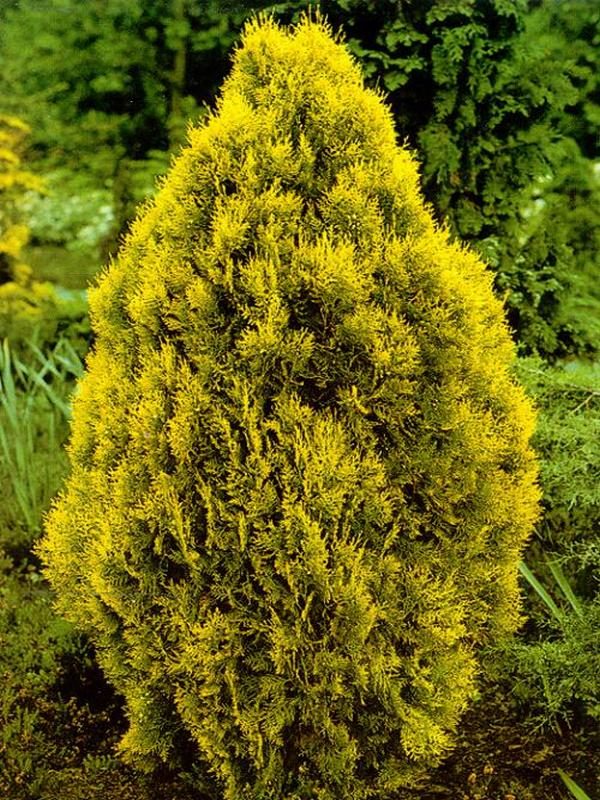
Thuja Sankist is a fairly large, cone-like shrub that has many densely planted twigs. The height of a mature bush does not exceed 3-4 m. It grows rather slowly and in a year it adds only 5 cm in diameter and height. This thuja grows well in containers and fits harmoniously into various landscape designs.
The needles of this variety have a bright, golden yellow color. When blooming, the needles are bright yellow, and with the arrival of winter they acquire a bronze color. If the thuja is planted in a sunny area, then its color will be as bright as possible. And in the shade, the needles become greener. If the Sankist lacks moisture, then a lot of seeds form on the branches and the shrub becomes less attractive.
In the reviews, gardeners note that thuja Sankist tolerates a drop in temperature, rather strong winds and unfavorable urban conditions. To make the crown more dense, it is advisable to plant this plant in places with light partial shade and good soil moisture. Sankist is rather picky about soils.
Advantages
- beautiful bright golden needles;
- an adult bush tolerates a drop in temperature well;
- reacts normally to dryness and excessive soil moisture;
- not picky about the composition of the soil.
disadvantages
- the increase in height is not fast.
Golden Smaragd
Rating: 4.8

Thuja Golden Smaragd variety is distinguished by the correct shape of the upper part of the plant, close to the cone. The dimensions of this thuja at 10 years old are 2.5 m in height and 0.7 m in width. The growth rate of this plant is average. The shrub looks good when planted alone. And also Smaragd is actively used to create hedges. It can be cut into various architectural shapes. This is best done in early March.
Smaragd has scaly and thick needles. It is pleasant to the touch. It remains golden yellow all year round. If you rub it in your hands, then a resinous aroma appears. At the initial blooming, the color of the needles is close to orange. To maintain the golden hue of the needles, it is recommended to plant this variety in partial shade or in well-lit places.
Consumers speak very well of the Golden Smaragd thuja variety. They note that the plant has good adaptive abilities. An adult plant is not afraid of low temperatures. The variety loves when the soil is moderately moist, but at the same time it reacts poorly to stagnant moisture, strong soil drying and dirty air. The shrub tolerates a sanitary cut adequately.
Advantages
- the needles remain golden yellow all year round;
- good winter hardiness;
- responds well to a haircut;
- high adaptive abilities.
disadvantages
- drought and does not tolerate much moisture.
Thuja Columna
Rating: 4.7
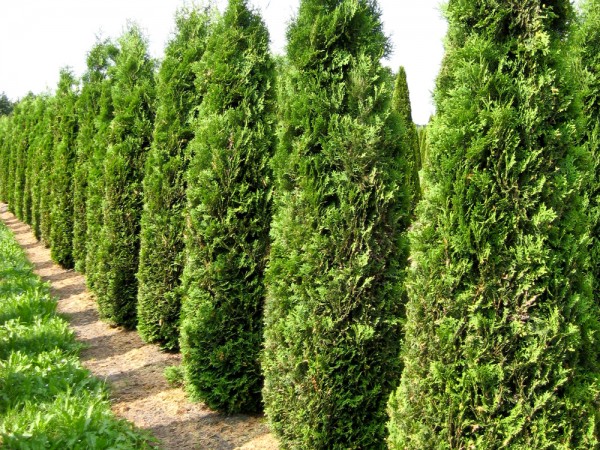
A pyramidal variety of thuja, which is a rather tall tree. Every year it grows by 20 cm. The maximum diameter of the crown is 1.5 m. It is dense and forms quite dense. Unpretentious, it is used for high, fundamental, non-shearing living walls from 5 to 8 meters high. You can grow this variety in groups or singly.
The needles of the thuja Columna are scaly. Her color is dark green and so it remains in winter. The needles shine beautifully in the sun. With sufficient light, the crown becomes thicker and brighter, and in the shade it 'goes bald'. This variety tolerates the pruning procedure normally, which will give the crown the desired shape. When planting a young tree, you need to provide high-quality protection for the winter so that the shoots do not get frostbite and do not get burns in the spring.
According to reviews, Columna exhibits the best frost resistance of all known columnar thuja varieties. It grows on soils with any composition. Also, many are impressed by the speed with which this tree grows upward. This variety of thuja does not need additional fertilization, but its growth strength will be better on fertile, moist soil.
Advantages
- growing rapidly upward;
- dense, dense crown;
- tolerates pruning normally;
- tolerates severe frosts well.
disadvantages
- does not tolerate drought well.
Thuja Fastigiata
Rating: 4.6
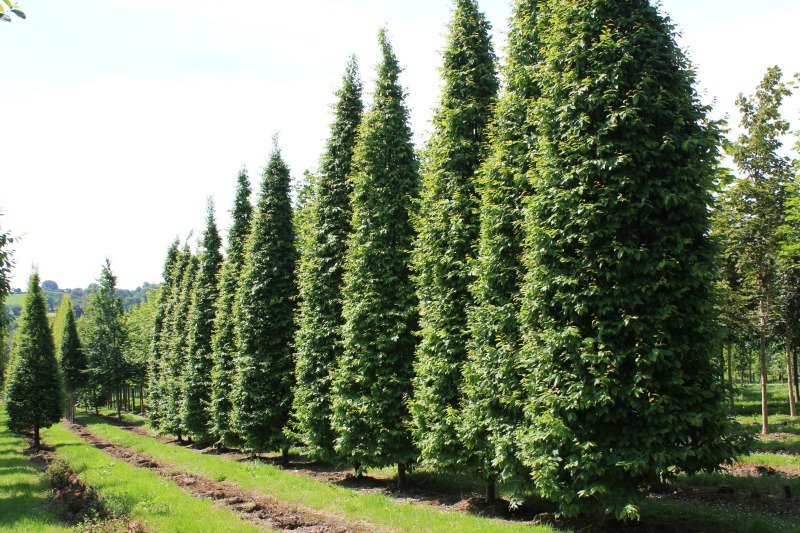
Thuja Fastigiata is a narrowly columnar variety. In shape, this tree resembles a cypress. Every year it adds about 30 cm in height, so it quickly reaches 10 m. But the diameter of its crown does not exceed 3 m. The stems are tightly pressed against the trunk. The crown consists of a large number of branches. Fastigiata looks good in single and group plantings.
Dark green needles practically do not change color all winter. It is soft to the touch and has a rather rich specific smell. There are cones on the crown, but they are hardly noticeable. Fastigiata does well in areas with good lighting or light partial shade. She is not picky about the composition of the soil, but prefers to keep it well hydrated.
In the reviews, landscape designers note that this variety has high winter hardiness. The plant is not damaged even in particularly severe winters. If the tree is planted in an area prone to stagnant moisture, then a drainage system is required. If the soil is very dry or the site is too shaded, then the thuja may lose its decorative effect.
Advantages
- resembles a cypress in shape;
- beautiful, memorable needles;
- responds well to haircuts and trims;
- high frost tolerance.
disadvantages
- in the shade, the crown may lose its decorative effect.
Holmstrup
Rating: 4.5
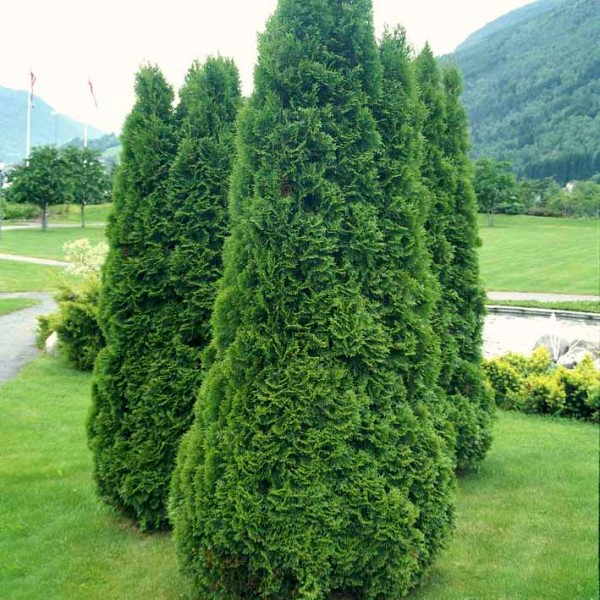
The thuja variety Holmstrup stands out for its narrow pyramidal crown. Even in adulthood, its height does not exceed 2 m. But at the same time Holmstrup always retains a columnar shape. For a year, the plant adds 10-20 cm in height, and 4-6 cm in width. This thuja looks organically if planted alone. It also fits well with the design of hedges, low alleys or garden labyrinths.
Holmstrup's needles have a dark green color, which remains so all winter. It is soft and scaly to the touch. The plant, even without formative pruning, retains its natural narrowly pyramidal appearance for a long time. The end branches of this thuja are arranged vertically. The undersized variety does not require a lot of planting area and does not shade other plants growing with it.
Holmstrup has many positive reviews. This variety is considered to be very easy to grow. Possesses high resistance to frost (can withstand temperatures as low as -35 ° C). Thuja occidentalis Holmstrup is well established in urban conditions, next to highways or an industrial zone. This variety is durable. Some botanists claim that in one place it can live up to 200 years.
Advantages
- memorable appearance;
- high vitality;
- does not shade neighboring plants;
- life expectancy up to 200 years.
disadvantages
- not identified.
Thuja Wagneri
Rating: 4.4
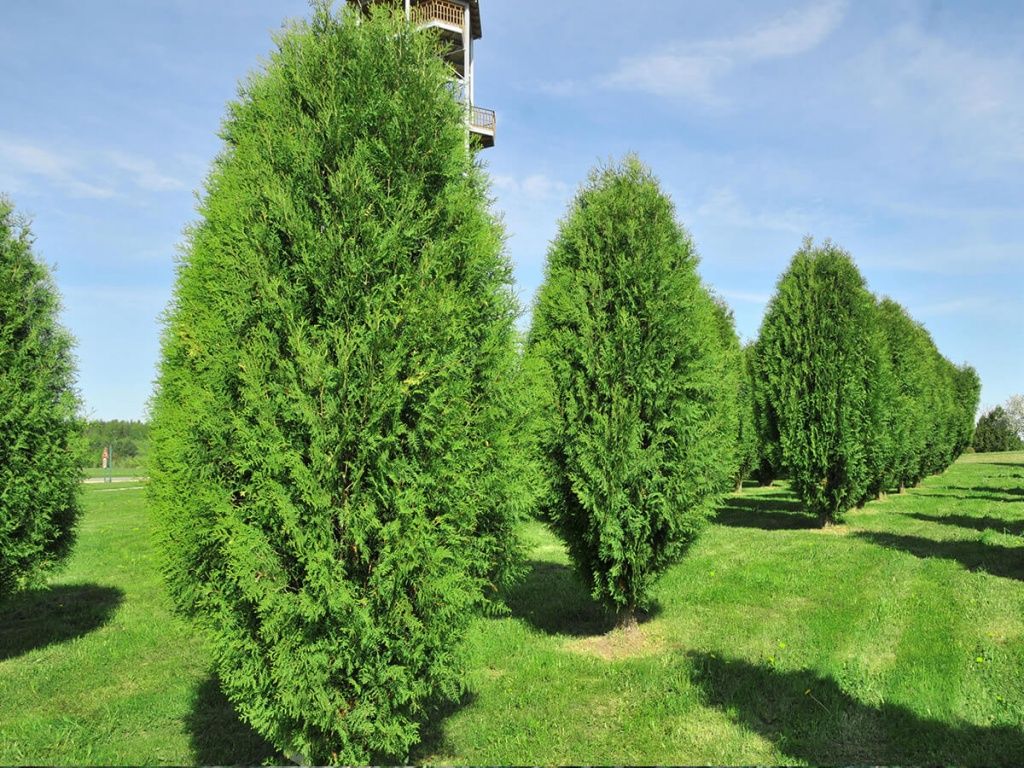
The German variety thuja Wagneri is a tree with an egg-shaped top. The diameter of the crown in an adult plant usually reaches 1 m, and it grows in height by 2-3 m. The crown of Wagneri thuja is dense, with a large number of branches and at the same time looks quite elegant. It is narrowly conical and grows strictly vertically. But the stems are thin and slightly droop down.
The needles of this variety of thuja are quite unusual – its color is gray-green. In winter, against the background of snow, this plant looks very elegant, since it acquires a copper tint. The previous color returns in the spring. For thuja Wagneri, open areas are better suited where a lot of light will fall on the plant. In areas with a dense shadow, the branches branch weakly, and the crown thins.
According to reviews, the Wagneri thuja tolerates severe frosts well. However, in the coming spring, after planting, you need to protect the young plant from getting sunburn. To do this, put on a dense burlap over the thuja. The tree looks most decorative on fertile, sufficiently moist soil. Thuja itself, without pruning, holds the decorative shape of the crown well.
Advantages
- the crown has a beautiful shape;
- colorful color of needles;
- interesting appearance against the background of snow;
- good frost tolerance.
disadvantages
- in shaded areas the crown is thinning.
The best varieties of thuja spherical
With proper planting and proper grooming, it is possible to achieve an ideal round, dense and healthy crown in spherical thuja varieties. In such plants, the size and color of the crown can vary greatly.
Thuja Reingold
Rating: 5.0

Thuja Reingold is a slow growing shrub. Over the course of a year, its width and height increase by only 5 cm. In a young plant, the crown is rounded, but with age it becomes more elongated. Often Reingold is grown in pots, which decorate balconies and terraces. This variety fits perfectly into landscaping of small areas.
On the thin soft branches of the thuja, there are a large number of needle-like leaves, which eventually become scaly. The color of the needles is yellow, close to golden, and in winter it becomes bronze. On the branches there are small (length – 0.7 cm), rounded, brown cones. This variety of thuja needs good lighting. If the plant is planted in the shade, the bright color of the needles will be lost.
Gardeners in the reviews note that Reingold performs better on sufficiently moist, fertile soils. And stagnant moisture negatively affects the condition of the plant. An adult plant is not afraid of a sharp drop in temperature. However, this variety of thuja suffers from sunburn with the arrival of spring. Reingold can suffer from aphids or spider mites attack.
Advantages
- adds color to hedges;
- needles with a golden color;
- looks spectacular on balconies and terraces;
- not afraid of winter frosts.
disadvantages
- deteriorates with stagnant moisture.
Tuya Hozeri
Rating: 4.9
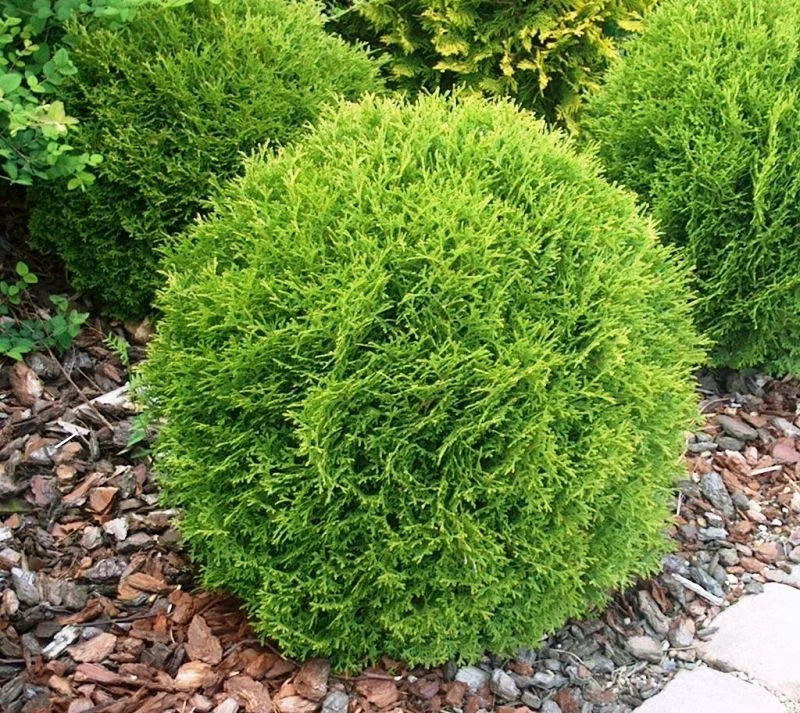
Polish breeders have bred the thuja Hoseri variety. The original form of this plant is spherical, and over time it becomes ovoid. The height of the shrub and the diameter of the volumetric crown reach 80 cm. This variety of thuja looks like a symmetrical, volumetric ball. These plants are planted alone or in a group with others. With their help, rocky or heather gardens are created.
The shrub is formed from numerous, intertwining shoots. Hoseri's needles are scaly, having a dark green color. Closer to winter, it becomes bronze, and in the spring it returns to its previous color. In order for the Hoseri crown to please the eye, it is better to plant the bush in open areas, and the soil must be sufficiently moist. If the area is heavily shaded, then the crown will become more rare.
According to reviews, Khozeri has high resistance in winter (it can withstand frosts down to -29 ° C). Strong gusts of wind are not terrible for this plant, but it tolerates drought rather poorly. Thuja reacts adequately to transplantation or formative / sanitary pruning. If the area where this bush grows is famous for snow piles, then it is recommended to protect the crown with the help of special frames.
Advantages
- looks like a small green ball;
- withstands fairly severe frosts;
- not afraid of strong winds;
- has many areas of use.
disadvantages
- in the shade, the crown thins.
Tuya Mister Bowling Ball
Rating: 4.8

Thuja Mister Bowling Ball is a ball-shaped shrub with patterned crown. The height of this plant is slightly less than a meter. The crown diameter is approximately the same. Thuja grows 5-6 cm per year. Such a shrub looks very organic in small gardens, and is also suitable for cultivation in containers that decorate the local area.
This variety of thuja has needles that resemble strings. Her color is gray-green. It is soft and very delicate to the touch. With the onset of winter, a light bronze tint appears on it. This variety has a natural beautiful compact, spherical crown, therefore pruning has an exclusively sanitary function. Broken, dry twigs are usually removed in early spring.
Landscape designers in the reviews note that this thuja is very resistant to the urban climate. She is not afraid of severe frosts, but can suffer from heavy snowfalls. This variety thrives better in sunny areas, but grows quite normally in light partial shade. But gardeners note that if you plant a shrub in a highly shaded place, then the crown will be less dense.
Advantages
- beautiful openwork crown;
- takes root well in the city;
- does not require formative pruning;
- tolerates temperature drop well.
disadvantages
- snow blockages can damage the crown.
Teeny Tim
Rating: 4.7
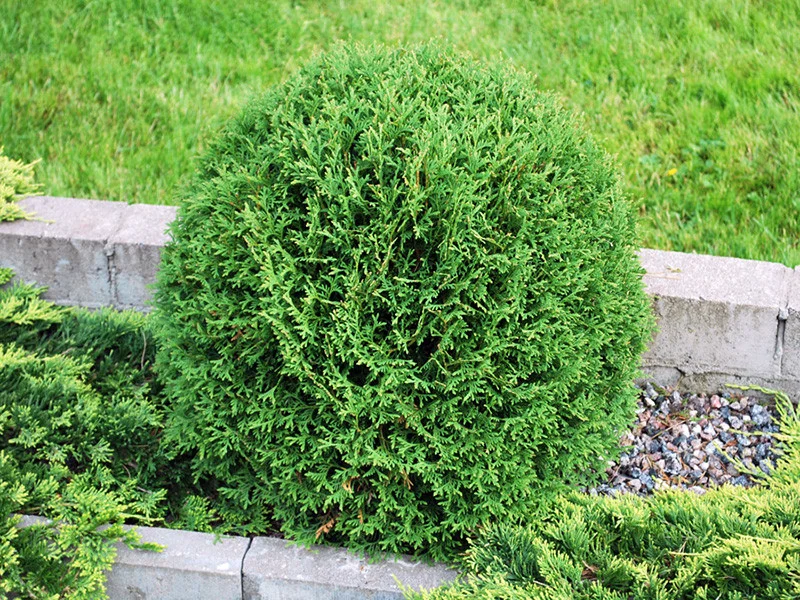
Thuja Tini Tim is a dwarf globular shrub. Its crown has thin branching. The plant is classified as slowly growing. It resembles a small mountain with a rounded top. The crown of a mature bush is 1.5 m in diameter. And its height usually does not exceed one meter. Tini Tim can be used alone or can complement other compositions.
Tiny Tim has scaly, bright green needles that shine beautifully in the sun. With the arrival of winter, it becomes more brown. Thuja shows its decorative properties in the best way when planting in areas with good lighting and sufficient soil moisture. In shaded conditions, the crown fades and becomes more rare. This thuja is undemanding to the composition of the soil. It normally tolerates dry soil and excessive moisture.
Many praise the Tini Tim thuja variety. They love that this ornamental shrub tolerates shearing and pruning well. This plant tolerates temporary waterlogging of the soil. Tiny Tim tolerates winter frosts well. With age, the bush increases its drought tolerance. It is appreciated in landscaping for its neat round crown, slow growth and unpretentious cultivation.
Advantages
- neat small ball;
- unpretentiousness in growing;
- tolerates shaping and sanitary manipulations well;
- not afraid of winter frosts.
disadvantages
- in the shade, the crown thins, the needles fade.
Tuya Little Jam
Rating: 4.6
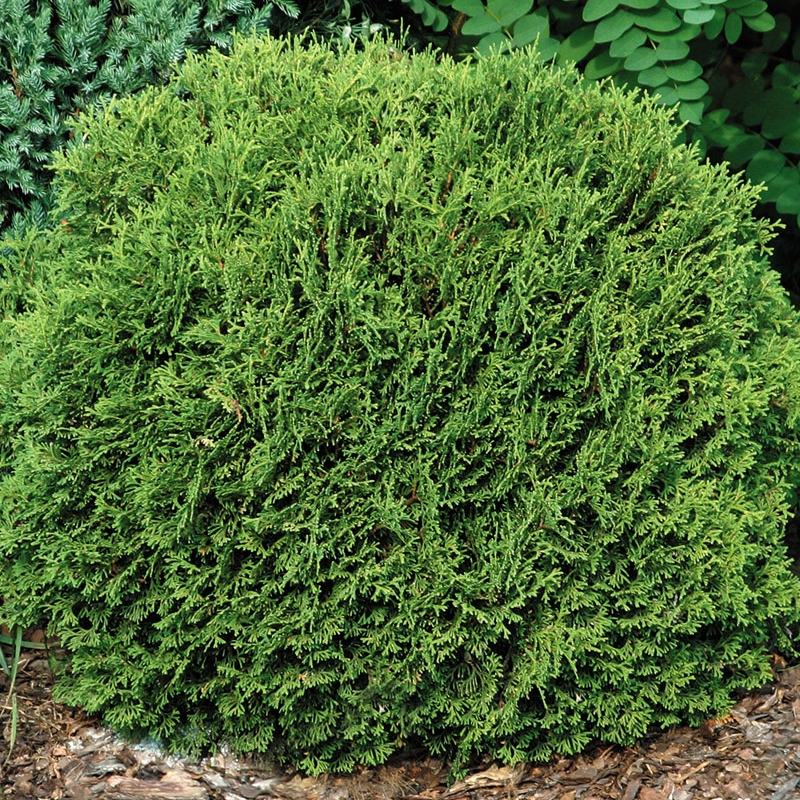
Thuja Little Jack has an asymmetrical crown. It grows a little less than a meter in height, and reaches one and a half meters in diameter. During the year, he adds 10-15 cm. There are a lot of stems on the bush. They are short and slightly curled. Shoots grow evenly: from the center they depart at an angle, looking to the sides and up. Thuja Little Jack makes an excellent hedge.
Little Jack has dark green scaly needles tightly pressed against the shoots. In winter, it becomes slightly brownish. On the branches, crayons (8-12 mm), oblong cones are also visualized. When they appear, they are light green, and over time they turn light brown. The root system of this plant is superficial. It reacts sharply to soil compaction.
According to reviews, Thuja western Little Jam prefers areas in open areas or in light partial shade. If the bush is in a dense shade, then its crown will noticeably thin out, and the needles will become dull. This variety of thuja can withstand frosts down to -35 ° C. On the other hand, an untreated plant can be damaged by aphids and scale insects. And also this bush does not tolerate waterlogging and soil compaction.
Advantages
- beautiful dwarf bush;
- grows well in urban environments;
- lends itself to haircut and curly shaping;
- not afraid of low temperatures.
disadvantages
- in the shade it loses its decorative properties.
Woodwardy
Rating: 4.5
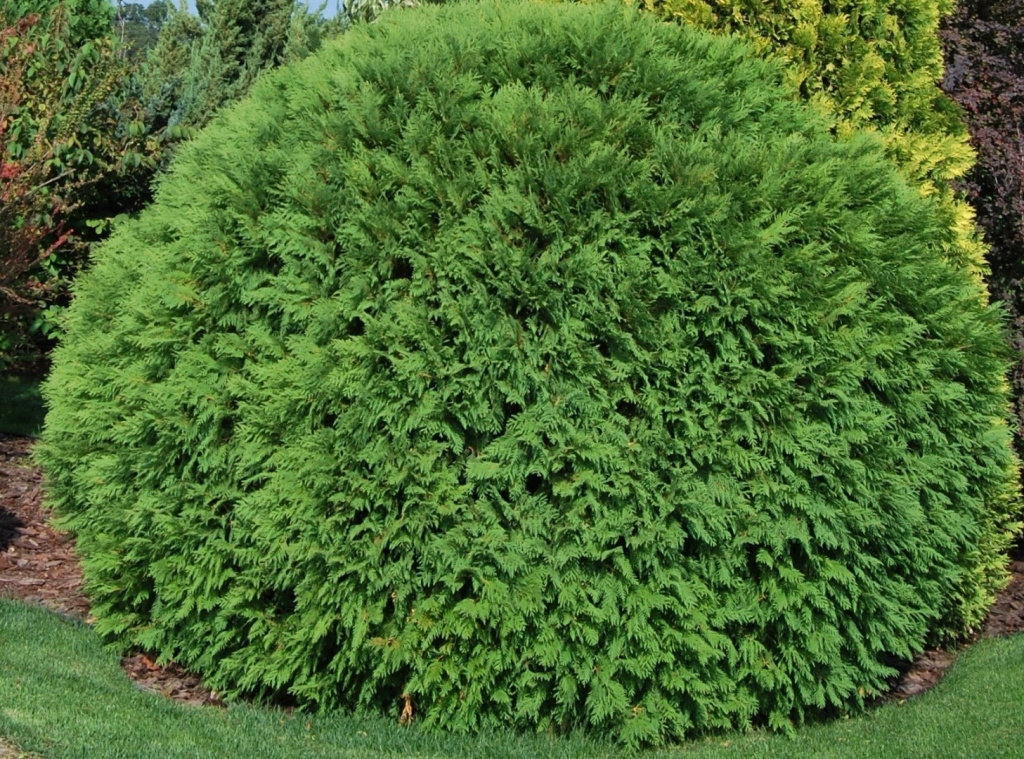
The thuja Woodwardi variety was introduced into cultivation even before 1923. The plant has a spherical crown that expands over time. At 10 years old, the height of thuja is 1.5 m. Shoots are densely planted, flat, grow straight. It is noteworthy that this thuja retains a rounded ovoid shape with sufficient growth.
Woodwardy's needles are scaly. Her color is dark green. When blooming, it has a golden tint, and in winter it becomes brownish green. There are also small brown cones on the branches. With sufficient light, the crown shape appears brighter. Tolerates haircuts and transplants. Responds adequately to feeding, especially at a young age. Later, the need for them disappears.
Gardeners in reviews note that Woodwardi's thuja is undemanding to soil compositions. It can take root in almost any place, but it likes the soil to be well moistened and drained. The soil is too dry and compacted he does not like it. Woodwardie tolerates severe frosts well, but at a young age can get sunburn of needles in early spring.
Advantages
- compact spherical crown;
- beautiful needles;
- undemanding to soil composition;
- feels good in winter.
disadvantages
- needles burns on young plants in early spring.
Thuya Miriam
Rating: 4.4

The new variety Miriam was obtained as a result of mutation of thuja Danica. It has a dense crown of the correct spherical shape. Thuja grows 5-10 cm per year. The crown diameter of this bush usually does not exceed 80 cm, and the height is 1 meter. For its miniature size, this variety is called a coniferous dwarf. Miriam fits seamlessly into various types of landscape designs.
This plant has a superficial root system. Miriam's needles are green with a yellowish tint. It is scaly in shape. In winter it becomes bronze, and with the arrival of spring it returns to its previous color. This thuja variety loves well-lit places. If you plant it in the shade, the needles will lose their beautiful natural shine, become looser, and the golden color of the needles will fade.
Reviews of the Miriam variety are mostly positive. The shrub is not afraid of frosts down to -35 ° C. However, for the winter, it is recommended to tie the crown or cover it with special cones that protect it from snow. The variety tolerates pruning and shaping cut well. Miriam grows well in containers that can be placed on balconies and terraces for decoration.
Advantages
- symmetrical crown;
- beautiful color of needles;
- not afraid of low temperatures;
- respond adequately to formative and sanitary pruning.
disadvantages
- in the shade, the crown becomes loose.
Tuya Danica
Rating: 4.3
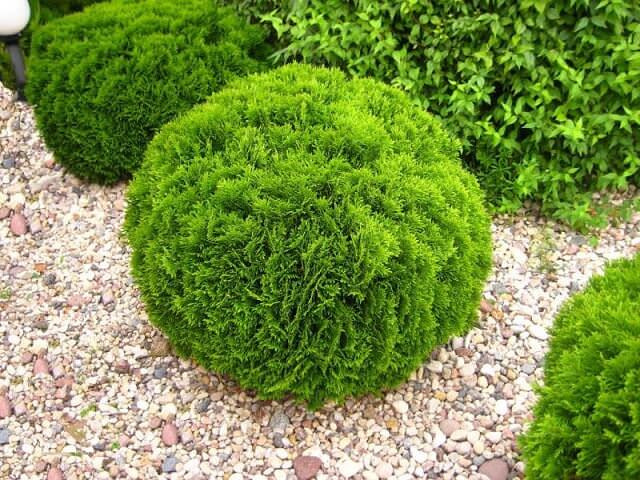
The Danish thuja Danica is a slow growing variety. For a year, he adds only 5 cm in height and width. A mature plant does not exceed 0.6 m in height. Tightly planted shoots are short and light green in color. The crown has a spherical shape and is quite thick. Used for growing in pots to decorate terraces, balconies and loggias. It is popular for gardening personal plots.
Danica's bark is peeling, having a reddish color. The needles have a deep green color and are soft to the touch. It shines beautifully in the light, and turns brownish-green in winter. Small (6 mm) buds are round and brownish in color. The plant tolerates cutting and shaping well, after which it becomes even thicker and brighter. In partial shade or shade, it can lose its shape and become loose, 'shaggy'.
According to reviews, thuja Danica is undemanding to the composition of the soil, tolerates dryness or excessive moisture. But it looks best on moderately moist clay soils. An adult bush tolerates severe frosts well and is not damaged. However, young thujas of this variety suffer from sunburn in early spring, so they need special measures.
Advantages
- beautiful spherical crown shape;
- responds adequately to cutting and shaping;
- not afraid of winter frosts.
disadvantages
- in the shade it becomes loose and 'shaggy'.
Attention! This rating is subjective and does not constitute an advertisement and does not serve as a purchase guide. Before buying, you need to consult with a specialist.


